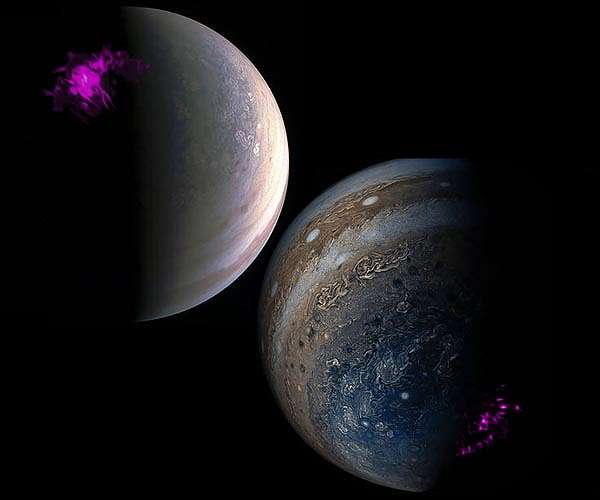Jupiter’s mysterious X-ray auroras have been explained, ending a 40-year quest for an answer. For the first time, astronomers have seen the way Jupiter’s magnetic field is compressed, which heats the particles and directs them along the magnetic field lines down into the atmosphere of Jupiter, sparking the X-ray aurora. The connection was made by combining in situ data from NASA’s Juno mission with X-ray observations from ESA’s XMM-Newton.
Credit: ESA/NASA/Yao/Dunn
Scientists from the Johns Hopkins Applied Physics Laboratory (APL) have helped solve a decades-old mystery as to how Jupiter produces a spectacular burst of X-rays every few minutes.
The X-rays are part of Jupiter’s aurora — bursts of visible and invisible light that occur when charged particles interact with the planet’s atmosphere. A similar phenomenon occurs on Earth, creating the northern lights, but Jupiter’s is much more powerful, releasing hundreds of gigawatts of energy, enough to briefly power all of human civilization. Jupiter’s X-ray aurora alone releases about a gigawatt, equivalent to what one power station might produce over a period of days.
In a new study, published in Science Advances, researchers combined close-up observations of Jupiter’s environment by NASA’s Jupiter-orbiting satellite Juno with simultaneous X-ray measurements from the European Space Agency’s (ESA) XMM-Newton observatory, which orbits Earth.
The research team, led by University College London and the Chinese Academy of Sciences, discovered that X-ray flares were triggered by periodic vibrations of Jupiter’s magnetic field lines. These vibrations create waves of plasma (ionized gas) that send heavy ion particles “surfing” along magnetic field lines until they smash into the planet’s atmosphere, releasing energy in the form of X-rays.
Critical measurements of the local environment came from APL’s Jupiter Energetic particle Detector Instrument (JEDI) on board Juno. Led by APL space physicist Barry Mauk, JEDI was built to measure the energetic ions and electrons that fill Jupiter’s system. Scientists compared JEDI measurements of the energetic ions and pulsations in the local plasma wave environment to pulsating X-ray emissions observed from XMM-Newton. There was a clear link between the energetic ions and emissions — leading researchers to the discovery that these were indeed the ions precipitating into Jupiter’s atmosphere creating the X-rays and addressing an important 40-year mystery.
“Jovian X-ray auroras have been studied for decades with remote Earth-orbiting X-ray observatories such as XMM-Newton, but their origins have remained enigmatic,” said George Clark, a space physicist at APL and a co-author of the study. “We know that Jupiter is the solar system’s greatest particle accelerator, so it had been thought that some of the accelerated particles from Jupiter’s vast space environment find their way into its upper atmosphere and collide with neutral material to generate X-rays. But it has never been proven until now.”
X-ray auroras occur at Jupiter’s north and south poles, often with clockwork regularity — during this observation, Jupiter was producing bursts of X-rays every 27 minutes.
The charged ion particles that hit the atmosphere originate from volcanic gas pouring into space from giant volcanoes on Jupiter’s moon, Io.
This gas becomes ionized (its atoms are stripped free of electrons) due to collisions in Jupiter’s immediate environment, forming a donut of plasma that encircles the planet.

In this study, researchers analyzed observations of Jupiter and its surrounding environment carried out continuously over a 26-hour period by the Juno and XMM-Newton spacecraft. They found a clear correlation between waves in the plasma detected by Juno and X-ray auroral flares at Jupiter’s north pole recorded by XMM-Newton. They then used computer modeling to confirm that the waves would drive the heavy particles toward Jupiter’s atmosphere.
Why the magnetic field lines vibrate periodically is unclear, but the vibration may result from interactions with the solar wind or from high-speed plasma flows within Jupiter’s magnetosphere.
Answering that question is one of the goals of a new mission concept developed by APL and recently presented at NASA’s Heliophysics 2050 Workshop. Dubbed Jupiter’s Global Magnetic Environment and Radiation Observatory (JUGGERNOT), the proposal outlines a mission to send a spacecraft to Jupiter’s intense radiation belts. The craft would carry the first dedicated X-ray imager to the planet, potentially elucidating the links between energetic charged particles and the resulting X-ray emissions.
“The results of the present study raise new and exciting questions about Jovian X-ray emissions, which may hold the key to understanding planetary magnetospheres,” Clark said. “JUGGERNOT would help us answer those questions, expanding the frontiers of heliophysics, with significant implications for planetary science and astrophysics as well.”
Jupiter’s magnetic field is extremely strong — about 20,000 times as strong as Earth’s — and therefore its magnetosphere, the area controlled by this magnetic field, is extremely large. If it was visible in the night sky, it would cover a region several times the size of our moon.
The work was supported by the Chinese Academy of Sciences, the National Natural Science Foundation of China, and the UK’s Science and Technology Facilities Council, Royal Society, and Natural Environment Research Council, as well as ESA and NASA.
Banner: A color-enhanced version of an image taken by NASA's Juno spacecrat on Oct. 24, 2017. The view captures one of the white ovals in the “String of Pearls,” one of eight massive rotating storms at 40 degrees south latitude on the gas giant planet. Credits: Enhanced Image by Gerald Eichstädt and Sean Doran (CC BY-NC-SA) based on images provided Courtesy of NASA/JPL-Caltech/SwRI/MSSS
Related Topics
For Media Inquiries
For all media inquiries, including permission to use images or video in our gallery, please contact:
Michael Buckley
All Media Resources

